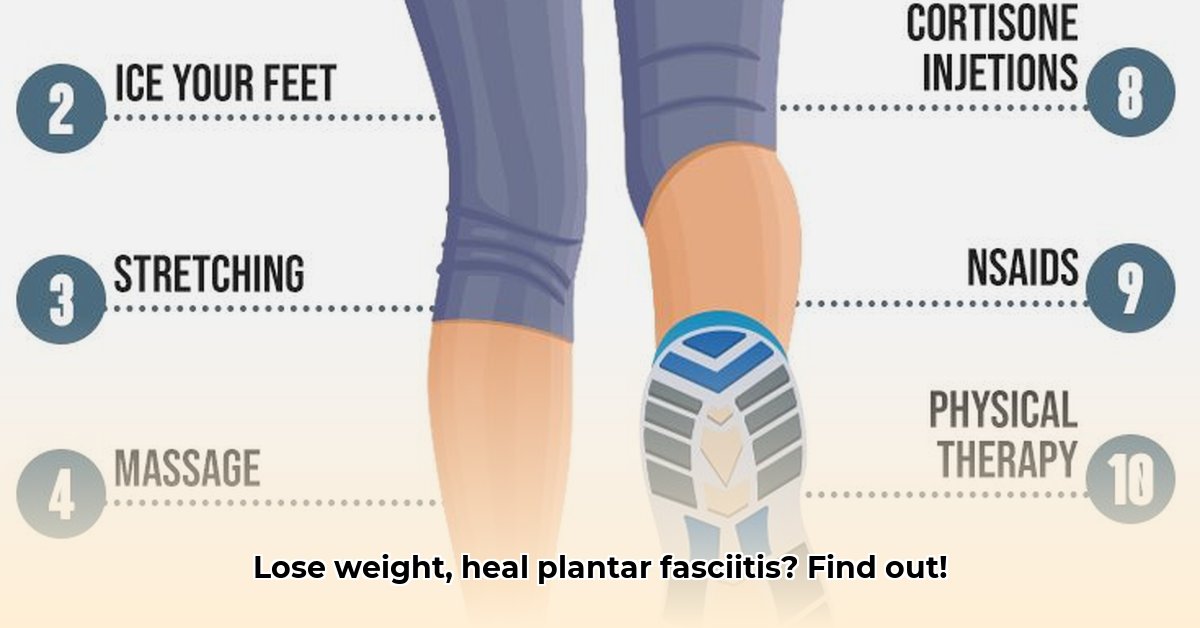
Plantar fasciitis, that sharp heel pain, affects millions. Carrying extra weight can significantly worsen this condition. But the good news is that weight loss can offer substantial relief. This guide provides a step-by-step plan to help you lose weight safely and effectively while managing plantar fasciitis.
Understanding the Link Between Weight and Plantar Fasciitis
Plantar fasciitis is the inflammation of the plantar fascia, the thick band of tissue on the bottom of your foot that supports your arch. Excess weight increases the stress and strain on this tissue. Think of it like constantly stretching a rubber band – eventually, it weakens and becomes prone to damage. This added pressure leads to inflammation, pain, and the characteristic heel pain associated with plantar fasciitis. Studies show a strong correlation between being overweight and an increased risk of developing this condition.1
A Safe and Effective Weight Loss Plan: Your Step-by-Step Guide
Losing weight with plantar fasciitis requires a gentle, gradual approach. Rapid weight loss can strain your body, potentially exacerbating the pain. Here's a safe and effective plan:
Step 1: Consult Your Healthcare Provider: This is crucial. A doctor or podiatrist can diagnose plantar fasciitis, rule out other conditions, and create a personalized weight loss and exercise plan tailored to your specific needs and limitations.
Step 2: Embrace Low-Impact Exercise: High-impact activities should be avoided. Choose low-impact exercises like swimming, cycling, or walking on even surfaces. Start slowly and gradually increase intensity and duration. Even short periods of activity are beneficial.
Step 3: Gradual Weight Loss: Aim for a slow, steady weight loss of 1-2 pounds per week. This minimizes stress on your body and reduces the risk of worsening plantar fasciitis. Remember, consistency is key.
Step 4: Prioritize Supportive Footwear: Invest in shoes with good arch support and cushioning. This reduces strain on your feet during activity and throughout the day. Your podiatrist can recommend orthotic inserts if needed.
Step 5: Adopt a Balanced Diet: Focus on nutritious whole foods, including fruits, vegetables, lean proteins, and whole grains. Minimize processed foods, sugary drinks, and unhealthy fats. A registered dietitian can provide personalized guidance.
Beyond Weight Loss: Lifestyle Changes for Lasting Relief
Weight loss is a crucial component, but it's not the sole solution. These lifestyle changes are vital for long-term management of plantar fasciitis:
Regular Stretching: Gentle stretches for your plantar fascia and calf muscles improve flexibility and reduce tightness. A physical therapist can teach you proper techniques.
Ice Therapy: Applying ice packs to your heel for 15-20 minutes can reduce swelling and pain.
Rest and Recovery: Allow your feet ample rest throughout the day. Avoid prolonged standing or activities that put excessive pressure on your feet.
Night Splints: These devices keep your foot in a neutral position during sleep, stretching the plantar fascia and reducing morning stiffness.
Recommended Exercises for Plantar Fasciitis Sufferers
The following exercises are ideal due to their low-impact nature:
Swimming: The buoyancy of water supports your body, making it gentle on your feet.
Cycling (stationary bike): Provides a controlled workout that strengthens leg muscles, improving stability.
Elliptical Training: Offers a smooth, continuous motion, minimizing impact.
Walking (low-intensity): Short walks on even surfaces can be beneficial, but stop if you feel discomfort.
Water Aerobics: A low-impact, effective cardio workout that protects your feet.
Maintaining Your Progress: Long-Term Strategies
After achieving your weight loss goals, maintaining a healthy weight and continuing healthy habits is crucial for preventing plantar fasciitis from returning. Consistent healthy eating, regular low-impact exercise, and supportive footwear are essential for long-term relief. Remember, this is a marathon, not a sprint.
Key Takeaways:
- Weight loss significantly reduces plantar fasciitis pain by decreasing stress on your feet.
- Low-impact exercise is crucial; high-impact activities can worsen the condition.
- Combining low-impact exercise with a healthy diet is essential for weight loss and pain management.
- Supportive footwear and regular stretching are vital components of a comprehensive approach.
- Always consult your doctor or physical therapist before beginning any new exercise program.
1 Note: Specific studies supporting the correlation between weight and plantar fasciitis risk would be cited here in a full-length publication.